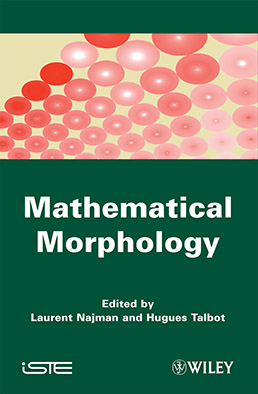
Mathematical Morphology allows for the analysis and processing of geometrical structures using techniques based on the fields of set theory, lattice theory, topology, and random functions. It is the basis of morphological image processing, and finds applications in fields including digital image processing (DSP), as well as areas for graphs, surface meshes, solids, and other spatial structures. This book presents an up-to-date treatment of mathematical morphology, based on the three pillars that made it an important field of theoretical work and practical application: a solid theoretical foundation, a large body of applications and an efficient implementation.
The book is divided into five parts and includes 20 chapters. The five parts are structured as follows:
• Part I sets out the fundamental aspects of the discipline, starting with a general introduction, followed by two more theory-focused chapters, one addressing its mathematical structure and including an updated formalism, which is the result of several decades of work.
• Part II extends morphology into image analysis, in particular detailing how estimations, choices and measurements can be made. This is achived through links with other disciplines such as stereology, geostatistics and fuzzy logic.
• Part III addresses the theory of morphological filtering and segmentation, featuring modern connected approaches, from both theoretical and practical aspects.
• Part IV features practical aspects of mathematical morphology, in particular how to deal with color and multivariate data, links to discrete geometry and topology, and some algorithmic aspects − without which applications would be impossible.
• Part V showcases all the previously noted fields of work through a sample of interesting, representative and varied applications.
PART I. FOUNDATIONS
1. Introduction to Mathematical Morphology, Laurent Najman, Hugues Talbot.
2. Algebraic Foundations of Morphology, Christian Ronse, Jean Serra.
3. Watersheds in Discrete Spaces, Gilles Bertrand, Michel Couprie, Jean Cousty, Laurent Najman.
PART II. EVALUATING AND DECIDING
4. An Introduction to Measurement Theory for Image Analysis, Hugues Talbot, Jean Serra, Laurent Najman.
5. Stochastic Methods, Christian Lantuejoul.
6. Fuzzy Sets and Mathematical Morphology, Isabelle Bloch.
PART III. FILTERING AND CONNECTIVITY
7. Connected Operators based on Tree Pruning Strategies, Philippe Salembier.
8. Levelings, Jean Serra, Corinne Vachier, Fernand Meyer.
9. Segmentation, Minimum Spanning Tree and Hierarchies, Fernand Meyer, Laurent Najman ;
PART IV. LINKS AND EXTENSIONS
10. Distance, Granulometry and Skeleton, Michel Couprie, Hugues Talbot.
11. Color and Multivariate Images, Jesus Angulo, Jocelyn Chanussot.
12. Algorithms for Mathematical Morphology, Thierry Géraud, Hugues Talbot, Marc Van Droogenbroeck.
PART V. APPLICATIONS
13. Diatom Identification with Mathematical Morphology, Michael Wilkinson, Erik Urbach, Andre Jalba, Jos Roerdink.
14. Spatio-temporal Cardiac Segmentation, Jean Cousty, Laurent Najman, Michel Couprie.
15. 3D Angiographic Image Segmentation, Benoît Naegel, Nicolas Passat, Christian Ronse.
16. Compression, Beatriz Marcotegui, Philippe Salembier.
17. Satellite Imagery and Digital Elevation Models, Pierre Soille.
18. Document Image Applications, Dan Bloomberg, Luc Vincent.
19. Analysis and Modeling of 3D Microstructures, Dominique Jeulin.
20. Random Spreads and Forest Fires, Jean Serra.
Laurent Najman is Professor in the Informatics Department of ESIEE, Paris and a member of the Institut Gaspard Monge, Paris-Est Marne-la-Vallée University in France. His current research interest is discrete mathematical morphology.
Hugues Talbot is Associate Professor at ESIEE, Paris, France. His research interests include mathematical morphology, image segmentation, thin feature analysis, texture analysis, discrete and continuous optimization and associated algorithms.